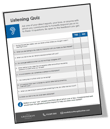The Art of Listening for What’s Not Being Said: Top 10 Tips

When words and actions don’t match as we’re listening; when we have a sense that something’s not quite feeling right in a conversation, there’s a common formula known as the 7-38-55 rule that might be helpful. It indicates only 7 percent of meaning is conveyed through the words we speak, and the remaining percent of meaning is informed by tone of voice (38 percent) and body language (55 percent). When there’s incongruence, a vast majority of the information shared is gleaned from what is NOT being said.
That’s why we can all benefit by learning to better pay attention to what’s not being said whether we’re the one communicating, the one receiving the communication, or both.
A Communicator’s Perspective
First, here are some things that get in the way from a sender’s perspective, and why it’s so critical to listen for what’s not being said:
- Sometimes, we don’t have the words or vocabulary, nor the emotional self awareness, to express what we’re feeling and get our needs out there.
- Other times, we are afraid to express our true thoughts or feelings.
- In today’s multi-tasking world, sometimes we just aren’t able to give all of our attention to a topic or spend enough time delving into why it matters to us.
In each of those cases, when we don’t know how or can’t find time to fully talk about a topic, the result is that we either avoid the conversation all together, or communicate in vague terms that might get glossed over and seem irrelevant to a listener.
A Listener's Perspective
From a listener’s perspective, what gets in the way?
- We talk too much and don’t listen enough.
- We listen to respond instead of listening to understand.
- We’re not listening for word clues or noticing body language that signify there’s additional information that is yet to be uncovered. Body language is an especially important consideration as today’s virtual workplace enables meetings from afar, but with limitations when it comes to seeing and reading the body language of participants.

How well do you truly listen? This free one-page quiz asks 10 questions (to be answered honestly by someone other than yourself) that address indications of whether or not you listen well. Take it today…the results may just surprise you.
Top 10 Tips on How to Listen Better for What's Not Being Said
What then can one do to better listen for what’s not being said?
- Be quiet and listen to understand (don’t think about what you will say next). Sometimes jotting down key take-aways or questions that come to mind while listening can be helpful so you can focus on what’s being said not what you want to commit to memory.
- Be curious. If you’re not a naturally curious person, ask yourself, “What does this person have to say and what does it make me wonder or want to know more about?”
- Listen for the underlying issue or emotion (a fight about dirty clothes on the floor isn’t about the clothes on the floor; there’s a larger issue at play).
- Ask clarifying questions to ensure you understand before moving on from a topic. Listen and clarify. Repeat, as needed.
- Trust your gut if you’re feeling like you’re not getting the complete story.
- Notice any body language changes (i.e., change in position, facial movements), which may be a cue or clue to ask more questions. If the conversation is happening virtually, ask that everyone appear on camera to the extent possible and pay particular attention to when the speaker is making eye contact on screen or looking down / off screen, which may indicate their discomfort with the topic at hand.
- Listen for any emotional clues that signal there might be more to the story, like extended pauses, subtle references or asides, and moments when the speaker appears to continue talking without adding new information.
- When we communicate effectively, we understand where another person is coming from. If you don’t understand where someone else is coming from (you don’t need to agree with them), it means you need to ask more questions.
- Ask yourself in your head during a pause in the conversation: “What’s not being said?”
- Take the time to allow for dialogue on a given topic before moving on to the next one by asking everyone present if they have any additional comments or questions.
There’s not a formula to learn how to listen for what’s not being said, and it will vary based on the person, relationship, or situation. That said, the strategies above are worth considering.
What one strategy to listen for what’s not being said would help you be more effective?
—David Grossman
Now more than ever, leaders play a pivotal role in connecting, calming, and inspiring their teams. A big part of that is leading with Heart First – click below to learn more about Heart First and order yours today.


Comments on this post